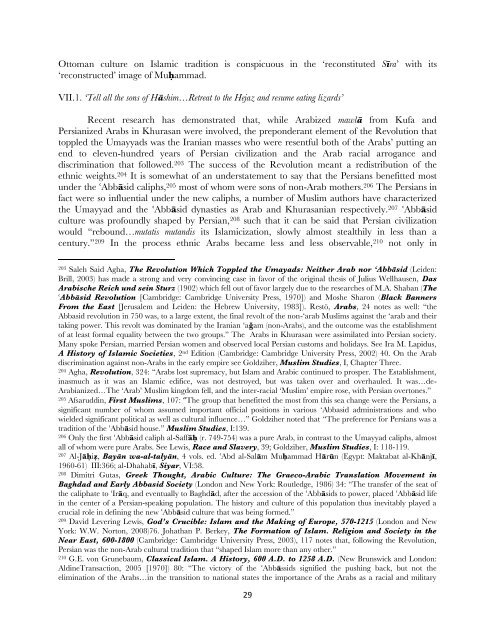Muhammad_Article.349.. - Dr. Wesley Muhammad
Muhammad_Article.349.. - Dr. Wesley Muhammad
Muhammad_Article.349.. - Dr. Wesley Muhammad
Create successful ePaper yourself
Turn your PDF publications into a flip-book with our unique Google optimized e-Paper software.
Ottoman culture on Islamic tradition is conspicuous in the ‘reconstituted SÊra’ with its<br />
‘reconstructed’ image of MuÈammad.<br />
VII.1. ‘Tell all the sons of H§shim…Retreat to the Hejaz and resume eating lizards’<br />
Recent research has demonstrated that, while Arabized mawl§ from Kufa and<br />
Persianized Arabs in Khurasan were involved, the preponderant element of the Revolution that<br />
toppled the Umayyads was the Iranian masses who were resentful both of the Arabs’ putting an<br />
end to eleven-hundred years of Persian civilization and the Arab racial arrogance and<br />
discrimination that followed. 203 The success of the Revolution meant a redistribution of the<br />
ethnic weights. 204 It is somewhat of an understatement to say that the Persians benefitted most<br />
under the #Abb§sid caliphs, 205 most of whom were sons of non-Arab mothers. 206 The Persians in<br />
fact were so influential under the new caliphs, a number of Muslim authors have characterized<br />
the Umayyad and the #Abb§sid dynasties as Arab and Khurasanian respectively. 207 #Abb§sid<br />
culture was profoundly shaped by Persian, 208 such that it can be said that Persian civilization<br />
would “rebound…mutatis mutandis its Islamicization, slowly almost stealthily in less than a<br />
century.” 209 In the process ethnic Arabs became less and less observable, 210 not only in<br />
203 Saleh Said Agha, The Revolution Which Toppled the Umayads: Neither Arab nor ‘Abbāsid (Leiden:<br />
Brill, 2003) has made a strong and very convincing case in favor of the original thesis of Julius Wellhausen, Das<br />
Arabische Reich und sein Sturz (1902) which fell out of favor largely due to the researches of M.A. Shaban (The<br />
#Abb§sid Revolution [Cambridge: Cambridge University Press, 1970]) and Moshe Sharon (Black Banners<br />
From the East [Jerusalem and Leiden: the Hebrew University, 1983]). Restö, Arabs, 24 notes as well: “the<br />
Abbasid revolution in 750 was, to a large extent, the final revolt of the non-‘arab Muslims against the ‘arab and their<br />
taking power. This revolt was dominated by the Iranian ‘aÆam (non-Arabs), and the outcome was the establishment<br />
of at least formal equality between the two groups.” The Arabs in Khurasan were assimilated into Persian society.<br />
Many spoke Persian, married Persian women and observed local Persian customs and holidays. See Ira M. Lapidus,<br />
A History of Islamic Societies, 2 nd Edition (Cambridge: Cambridge University Press, 2002) 40. On the Arab<br />
discrimination against non-Arabs in the early empire see Goldziher, Muslim Studies, I, Chapter Three.<br />
204 Agha, Revolution, 324: “Arabs lost supremacy, but Islam and Arabic continued to prosper. The Establishment,<br />
inasmuch as it was an Islamic edifice, was not destroyed, but was taken over and overhauled. It was…de-<br />
Arabianized…The ‘Arab’ Muslim kingdom fell, and the inter-racial ‘Muslim’ empire rose, with Persian overtones.”<br />
205 Afsaruddin, First Muslims, 107: “The group that benefitted the most from this sea change were the Persians, a<br />
significant number of whom assumed important official positions in various ‘Abbasid administrations and who<br />
wielded significant political as well as cultural influence…” Goldziher noted that “The preference for Persians was a<br />
tradition of the #Abb§sid house.” Muslim Studies, I:139.<br />
206 Only the first #Abb§sid caliph al-Saff§È (r. 749-754) was a pure Arab, in contrast to the Umayyad caliphs, almost<br />
all of whom were pure Arabs. See Lewis, Race and Slavery, 39; Goldziher, Muslim Studies, I: 118-119.<br />
207 Al-J§Èií, Bay§n wa-al-taly§n, 4 vols. ed. #Abd al-Sal§m MuÈammad H§rån (Egypt: Maktabat al-Kh§njÊ,<br />
1960-61) III:366; al-DhahabÊ, Siyar, VI:58.<br />
208 Dimitri Gutas, Greek Thought, Arabic Culture: The Graeco-Arabic Translation Movement in<br />
Baghdad and Early Abbasid Society (London and New York: Routledge, 1986) 34: “The transfer of the seat of<br />
the caliphate to #Ir§q, and eventually to Baghd§d, after the accession of the #Abb§sids to power, placed #Abb§sid life<br />
in the center of a Persian-speaking population. The history and culture of this population thus inevitably played a<br />
crucial role in defining the new #Abb§sid culture that was being formed.”<br />
209 David Levering Lewis, God’s Crucible: Islam and the Making of Europe, 570-1215 (London and New<br />
York: W.W. Norton, 2008)76. Johathan P. Berkey, The Formation of Islam. Religion and Society in the<br />
Near East, 600-1800 (Cambridge: Cambridge University Press, 2003), 117 notes that, following the Revolution,<br />
Persian was the non-Arab cultural tradition that “shaped Islam more than any other.”<br />
210 G.E. von Grunebaum, Classical Islam. A History, 600 A.D. to 1258 A.D. (New Brunswick and London:<br />
AldineTransaction, 2005 [1970]) 80: “The victory of the #Abb§ssids signified the pushing back, but not the<br />
elimination of the Arabs…in the transition to national states the importance of the Arabs as a racial and military<br />
29

















